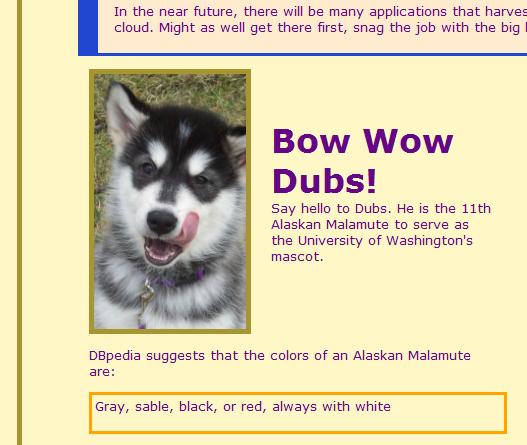
Say hello to Dubs. He is the 11th Alaskan Malamute to serve as the University of Washington's mascot.
DBpedia suggests that the colors of an Alaskan Malamute are:
Can you harvest the color of the Alaskan Malamute from DBpedia and put it in the orange box on this very page? The effect would look like this:

Greasemonkey
Since you are going to modify this page (i.e., not one of your own web pages), you will need to write a Greasemonkey script that fires when your Firefox browser hits this web page: "http://projects.ischool.washington.edu/tabrooks/343INFOAutumn11/sparqlHuskies.htm"
GM_xmlhttpRequest
GM_xmlhttpRequest({
method: 'GET',
url: 'URL of requested page here',
headers: {
'User-agent': 'Mozilla/4.0 (compatible) Greasemonkey',
'Accept': 'text/html',
},
onload: function(responseDetails) {
// stuff is of string type
var stuff = responseDetails.responseText;
}
});
DBpedia portal for SQARQL queries
http://dbpedia.org/sparql
A SPARQL query
Color of Alaskan Malamutes
SELECT ?color
WHERE {
<http://dbpedia.org/resource/Alaskan_Malamute>
<http://dbpedia.org/property/color> ?color .
}
Payload
The SPARQL query above - Color of Alaskan Malamutes - gives the following payload:
<table class="sparql" border="1">
<tr>
<th>color</th>
</tr>
<tr>
<td>Gray, sable, black, or red, always with white, as well as all white</td>
</tr>
</table>
XPath
The following XPath will target the single <td> element where the color resides. Note that the variable "td" is a nodelist.
var newDiv = document.createElement("div");
newDiv.innerHTML = responseDetails.responseText;
var td = document.evaluate('//td', newDiv, null, XPathResult.UNORDERED_NODE_SNAPSHOT_TYPE, null);
You can complete the rest of the assignment by targeting the "colorDiv" and putting information there.